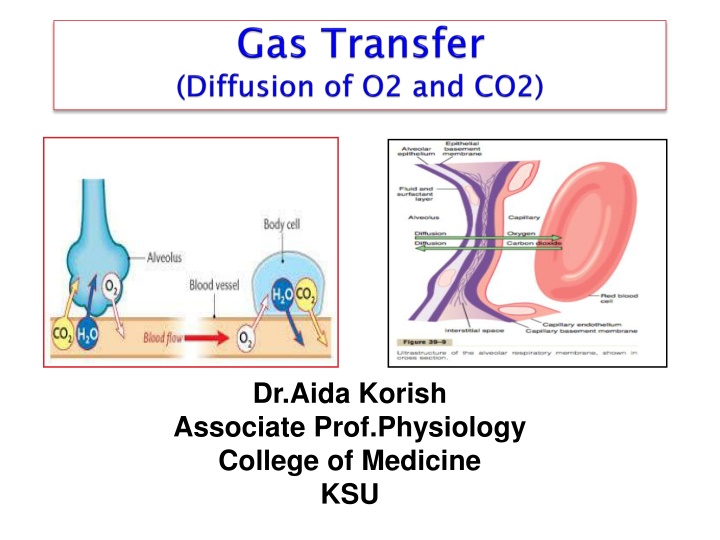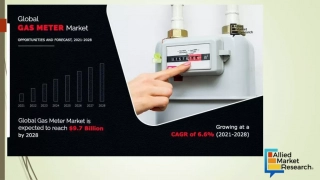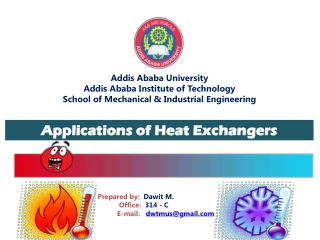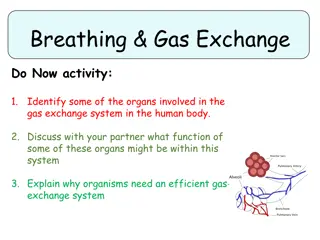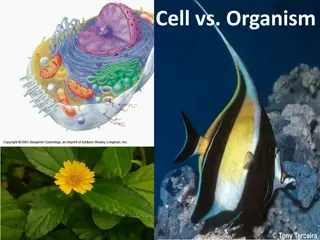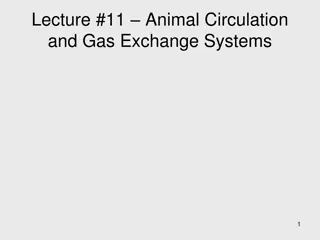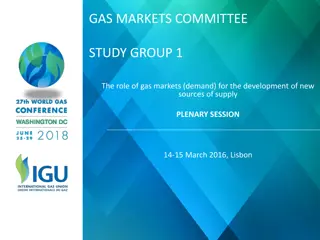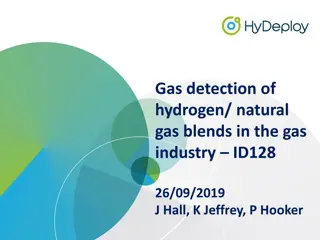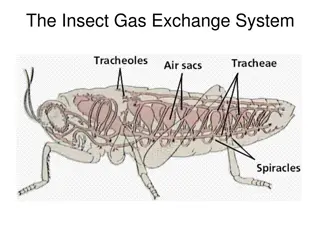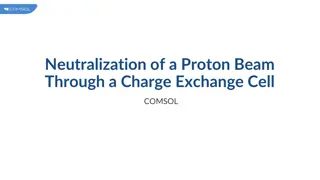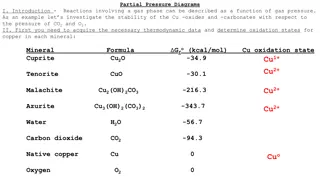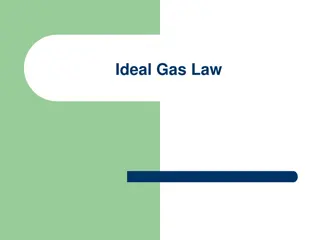Gas Pressures & Exchange in Physiology
Explore the principles of gas exchange in the respiratory system, focusing on partial pressures, diffusion across membranes, and factors influencing gas concentration. Understand the significance of O2 and CO2, their diffusion rates, and atmospheric gas composition.
Download Presentation

Please find below an Image/Link to download the presentation.
The content on the website is provided AS IS for your information and personal use only. It may not be sold, licensed, or shared on other websites without obtaining consent from the author.If you encounter any issues during the download, it is possible that the publisher has removed the file from their server.
You are allowed to download the files provided on this website for personal or commercial use, subject to the condition that they are used lawfully. All files are the property of their respective owners.
The content on the website is provided AS IS for your information and personal use only. It may not be sold, licensed, or shared on other websites without obtaining consent from the author.
E N D
Presentation Transcript
Dr.Aida Korish Associate Prof.Physiology College of Medicine KSU
Define partial pressure of a gas, how is influenced by altitude. Understand that the pressure exerted by each gas in a mixture of gases is independent of the pressure exerted by the other gases (Dalton's Law) Understand that gases in a liquid diffuse from higher partial pressure to lower partial pressure (Henry s Law) Describe the factors that determine the concentration of a gas in a liquid. Describe the components of the alveolar-capillary membrane Identify the various factors determining gas transfer: - Surface area, thickness, partial pressure difference, and diffusion coefficient of gas State the partial pressures of oxygen and carbon dioxide in the atmosphere, alveolar gas, at the end of the pulmonary capillary, in systemic capillaries, and at the beginning of a pulmonary capillary. Dr.Aida Korish ( akorish@ksu.edu.sa)
After ventilation of the alveoli with fresh air the next step is the process called Diffusion of oxygen and carbon dioxide across the respiratory membrane (alveolo-capillary membrane). Thickness of the respiratory membrane is 0.2 -0.6 micrometer. Surface area is about 70 m2 . The total quantity of blood in the capillaries of the lungs at any given instant is 60 to 140 ml. This small amount of blood spread over the entire surface of a 25 30-foot floor, and it is easy to understand the rapidity of the respiratory exchange of O2 and CO2.
The gases of physiological importance are O2,CO2. The rate of diffusion of each of these gases is directly proportional to the pressure caused by this gas alone which is called the partial pressure of the gas Pressure is caused by the constant impact of kinetically moving molecules against a surface.. The pressure of a gas acting on the surfaces of the respiratory passages and alveoli is proportional to the summated force of impact of all the molecules of that gas striking the surface at any time. This means that the pressure is directly proportional to the concentration of the gas molecules. Dr.Aida Korish ( akorish@ksu.edu.sa)
Atmospheric air is composed almost entirely of nitrogen and O2; it normally contains almost no CO2 and little water vapor. As soon as the atmospheric air enters the respiratory passages, it is exposed to the fluids that cover the respiratory surfaces. Even before the air enters the alveoli, it becomes almost totally humidified.
It states that the partial pressure of a gas in a mixture of gases is the pressure that gas would exert if it occupied the total volume of the mixture. Thus partial pressure is the total pressure multiplied by the fractional concentration of dry gas, or for humidified gas : : PX = Partial pressure of gas (mm Hg) PB = Barometric pressure (760mm Hg) PH2O = Water vapor pressure at 37 C (47 mm Hg) F = Fractional concentration of gas (0.21 no units) The barometric pressure (PB) is the sum of the partial pressures of O2, CO2, N2, and H2O. The percentages of gases in dry air at a barometric pressure of 760 mm Hg are as follows: Because air is humidified in the airways, water vapor pressure is obligatory and equal to 47 mm Hg at 37 C. Px PX Px = = PB PX = = (PB PB F F (PB PH PH2 2O) O) F F O2, 21% (0.21); N2, 79% (0.79); CO2, 0% (0).
Oxygen concentration in the atmosphere is 21%. So PO2 in atmosphere = 760 mmHg x 21% = 160 mmHg. This mixes with old air already present in alveolus to arrive at PO2 of 104 mmHg in alveoli. Carbon dioxide concentration in the atmosphere is 0.04%. So PCO2 in atmosphere =760 mmHg x 0.04% = 0.3 mm Hg This mixes with high CO2 levels from residual volume in the alveoli to arrive at PCO2 of 40 mmHg in the alveoli. Dr.Aida Korish ( akorish@ksu.edu.sa)
D P x A x S d x MW 1. P: Partial pressure differences 2. A: Surface area for gas exchange [The total surface area of the respiratory membrane is ~ 50 to 100 m2 in normal adult.] 3. d: Diffusion distance [thickness of the respiratory membrane] 4. MW: Molecular weight of gas 5. S :solubility of gas in the body fluids. S/ MW is called the diffusion coefficient of the gas. 6. The temperature of the fluid. In the body, the temperature remains reasonably constant and usually need not be considered. Dr.Aida Korish ( akorish@ksu.edu.sa)
O2 has lower molecular weight than CO2 but CO2 is 24 times more soluble than O2 Net result: CO2 diffusion approx. 20 times faster than O2 diffusion The partial pressure of a gas in a solution is determined not only by its concentration but also by the solubility coefficient of the gas. Henry s law: Partial pressure = Concentration of dissolved gas Solubility coefficient Therefore, the partial pressure of carbon dioxide (PCO2)(for a given concentration) is less than one twentieth that exerted by oxygen. The relative rates at which different gases at the same pressure level will diffuse are proportional to their diffusion coefficient. For O2 = 1.0 CO2 = 20.0 N2 = 0.53 Dr.Aida Korish ( akorish@ksu.edu.sa)
Alveolar air concentrations of gases are different from the atmospheric air due to several reasons. 1-The alveolar air is only partially replaced by atmospheric air with each breath {Only 350 milliliters of new air is brought into the alveoli with each normal inspiration, and this same amount of old alveolar air is expired. i.e The volume of alveolar air replaced by new atmospheric air with each breath is only one seventh of the total, 2-Oxygen is being absorbed into the pulmonary blood from the alveolar air. 3- Carbon dioxide is diffusing from the pulmonary blood into the alveoli. 4- Dry atmospheric air is humidified even before it reaches the alveoli. Dr.Aida Korish ( akorish@ksu.edu.sa)
The slow replacement of alveolar air is of particular importance in preventing sudden changes in gas concentrations in the blood. This makes the respiratory control mechanism much more stable Helps prevent excessive increases and decreases in tissue oxygenation, tissue CO2 concentration, and tissue pH when respiration is temporarily interrupted.
Normal expired air, containing both dead space air and alveolar air. It has gas concentrations and partial pressures that is between those of alveolar air and humidified atmospheric air. Dr.Aida Korish ( akorish@ksu.edu.sa)
From systemic capillaries to tissues From alveoli to pulmonary capillaries Dr.Aida Korish ( akorish@ksu.edu.sa)
from the Pulmonary Capillaries into the Alveoli from the peripheral tissue cells into the Capillaries Dr.Aida Korish ( akorish@ksu.edu.sa)
At resting condition 250 ml of oxygen are extracted by the tissues at ventilation rate of 4.2 L/min. During exercise 1000 ml of oxygen is extracted by the tissues per minute, the rate of alveolar ventilation must increase 4 times to maintain the alveolar PO2 at the normal value of 104 mmHg. *Therefore, oxygen concentration in the alveoli, and its partial pressure are controlled by: (1) The rate of absorption of oxygen into the blood. (2) The rate of entry of new oxygen into the lungs by the ventilatory process.
Normal rate of CO2 excretion is 200 ml/min, at normal rate of alveolar ventilation of 4.2 L/min. The alveolar PCO2 increases directly in proportion to the rate of carbon dioxide excretion by tissues. The alveolar PCO2 decreases in inverse proportion to alveolar ventilation. Dr.Aida Korish ( akorish@ksu.edu.sa)
